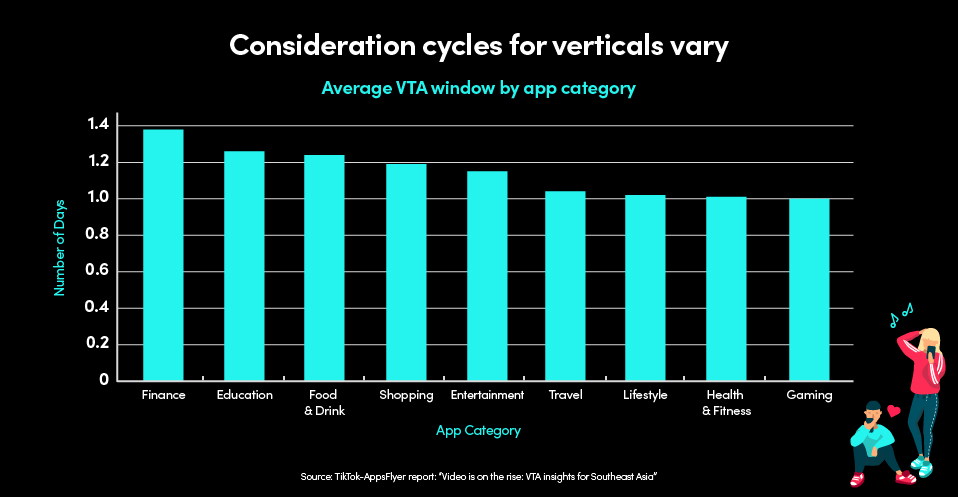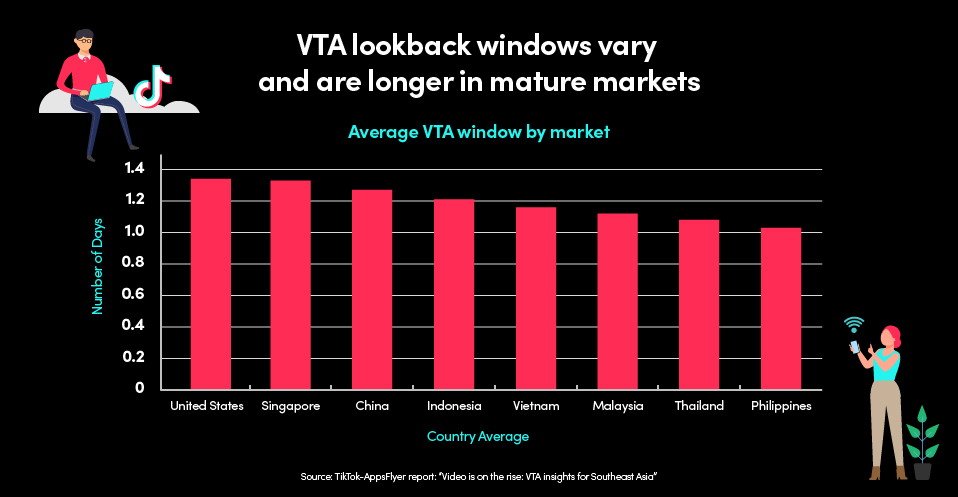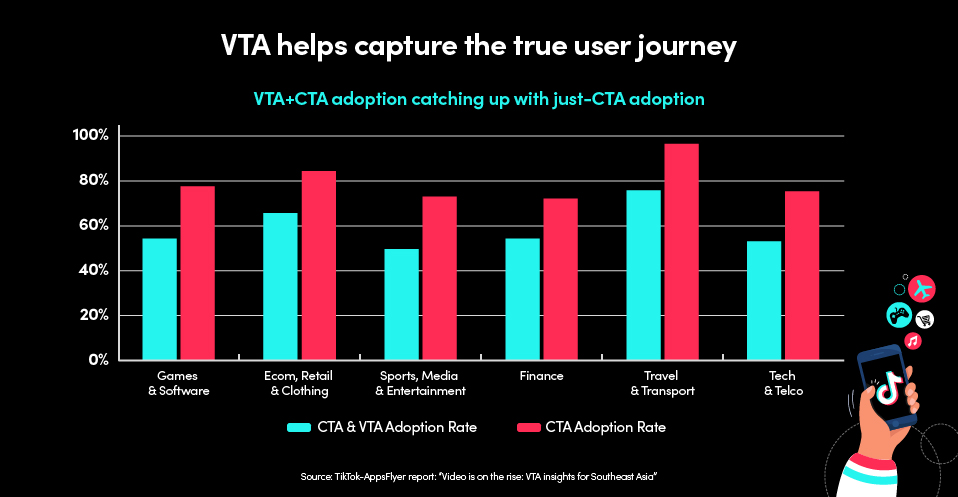How to Make View-Through-Attribution Work for Your Business

How to Make View-Through-Attribution Work for Your Business
26 August 2021
TikTok For Business
TrendsPerspectivesInsights
It's easy to get caught up with the Click-Through Attribution (CTA) model. Its charm is simple: you can measure campaign performance at the point of conversion. But if you’d read our first blog post in this two-part series,Realizing the True Value of a View, you’d know the pitfalls. The CTA model alone won’t give you the full picture of your campaign’s performance. Most products command long sales cycles, have multiple customer touch points, or both. This means conversions often won’t happen instantly.
We instead introduced a hybrid model – combining View-Through Attribution (VTA) with CTA as the latest and, arguably, most effective and accurate way to measure campaign performance. We proved this with the AppsFlyer-TikTok report, "Video is on the rise: View-Through Attribution (VTA) Insights for Southeast Asia."
With data backed by AppsFlyer’s analysis of 14K apps and 10.39B installs analyzed across social media platforms, it’s clear that VTA and CTA together is offering advertisers a more complete picture of campaign performance, and more importantly, giving advertisers the opportunity to optimize their media spend and performance.
But knowing that you should add VTA to your campaign measurement is just one part of the equation. The second half of the equation is setting up a VTA model that works best for your business. Namely, setting the length of your VTA attribution window, which requires balance and know-how. Through this blog post, we’ll walk you through some best practices. By the end of this, you’ll be comfortable to get started on adopting the VTA + CTA attribution model.
What makes a good VTA model
To understand the VTA model, you’ll have to consider the customer journey. A customer may first encounter the product through an video ad on TikTok. TheAppsFlyer-TikTok report shows that while only 14% of TikTok users click on an ad, users across the board are simply immersed on the platform, and engaged longer. TikTok users in Southeast Asia will spend up to 389 seconds per session on the platform, which is nearly double the time spent than on the second most-engaged platform.
If there’s interest in the promoted product, the next step that often follows is research. This means browsing a search engine for articles, or further research within the TikTok community for social proof and validation. These are a few example touch points that the user will go through before converting. This means, they’re unlikely to convert the instant they see the ad. After all, would you spend your hard-earned money on a product you’re seeing for the first time?
With the VTA model, you’re giving credit to the video ad view for the conversion, but within an attribution window. And there’s a bit of a science to identifying the ideal attribution window period. Particularly as the attribution window may differ from business to business. If the window is too long, you’ll be giving your TikTok campaign too much credit. You’ll also be cannibalizing organic performance. Too short of a window though, you might not be giving the campaign enough credit where due and underweights the value of a video view.
How to determine an attribution window
Higher the price, longer the window - Rule of thumb, for big-ticket items (e.g., electronics and white goods) or items that tend to command a longer consideration cycle (e.g., insurance or other financial products), you’ll want to set a longer attribution window.
Attribution window length varies across industries. For example, our report finds that the optimal attribution window for financial products and services tops out at 1.4 days. This is followed by education with nearly 1.3 days and F&B with just over 1.2 days. Gaming, on the other hand, bottoms out on the list with just a 24-hour attribution window.

Consumers in mature markets spend more time considering - When identifying a VTA window period, you’d also have to consider the market you’re promoting to. Across all markets, VTA window is at least a day. However, users in mature markets such as Singapore will take longer than average before converting.

Consumer behavior is seasonal – Keep in mind, that when the shopping season rolls around, advertisers are competing for customers. It’s around this time that customers are also willing to splurge, especially for a great deal. So, during these holiday seasons or local festivals, expect customer behavior to shift as they become more willing to make impulse purchases.
Case in point, according to our report, the Christmas holiday season tends to drive higher volume of app installs across Southeast Asia. This includes Singapore, Indonesia, Malaysia and the Philippines as these markets reached an install rate high of between 23% and 25% in December 2020.
TikTok users are also consistently discovering new products on their For You feed. In fact, according to a TikTok commissioned study of 1,815 users in Southeast Asia, 55% of users claimed to have made more unexpected purchases on TikTok despite having a shopping list.
This is coupled with growing interest in shopper-tainment content, particularly livestreams where brands and creators entertain users with live video content and two-way engagement. More importantly, users can seamlessly buy products off the content platform. According to an iKala report, social shopping across Thailand, Singapore, Vietnam and the Philippines soared, with orders and gross merchandise value (GMV) up 115% and 306%, respectively, compared to the same period the year before.
For an advertiser, this means that during such seasons, you can shorten your attribution window. The intent to make a purchase peaks during such periods. Audiences are more likely to click on your ad or convert in a shorter amount of time than compared to normal periods.
How to know if your VTA + CTA model works
As with most campaigns, settling on your ideal VTA + CTA model takes a bit of A/B testing. But there are a few markers that’ll indicate whether you’ve found a sweet spot for your attribution window. When you switch on the hybrid model, you should see a higher number of conversions as well as a more favorable return on your investment on a per-engagement cost basis.
In fact, the VTA model among some industries is accounting for a higher percentage of its conversions. Between October 2020 and April 2021, several industries saw an uptick in VTA adoption with E-Commerce reaching a high of 38.95% in share of conversions. The Media & Entertainment industry saw 28.5% of its conversions come from the VTA model. And VTA adoption is going to be more prevalent across industries.

There’s also another reason to keep the VTA model in mind for upcoming campaigns. Apple is implementing its new App Tracking Transparency (ATT) feature. The update, introduced through iOS 14.5 in March 2021, is changing how ad campaigns are measured. Users can opt out of ads by choosing to opt out of the ATT prompt. This makes it even harder for marketers to correctly attribute ads and efficiently measure campaigns. Despite this, Apple will still allow the VTA model as a way to measure the efficacy of an ad campaign. Apple's support for VTA when an ad is displayed for a minimum of three seconds is further testimony that the last-click attribution model is not in vogue. So if you’re looking to effectively reach potential customers on iOS14, you’ll want to implement the combined model.
Staying on top
With the mobile advertising industry changing, the best performers tend to be quick to adapt to new trends or changes. Whether it’s the changing mobile consumption habits that suggest Southeast Asian consumers increasingly prefer video, or Apple’s major changes to the way it tracks users, tools like VTA on TikTok are what you’ll need to stay ahead.
In summary, to make VTA work for you:
· Take an iterative approach to identifying a best-fit attribution window
· Consider factors such as market maturity, industry, consumer purchase behavior and seasonality
· Use A/B testing as a structured way to reach a suitable model
· Measure success with metrics such as number of conversions and cost-per-engagement
Now that you have a better grasp of the model, you should be feeling more comfortable with exploring your first VTA + CTA attribution model. And you’ll likely see a more holistic view of your ad campaign’s performance. This means you as an advertiser will be equipped to make more informed decisions on how you can optimize and best utilize TikTok to achieve your business goals.
